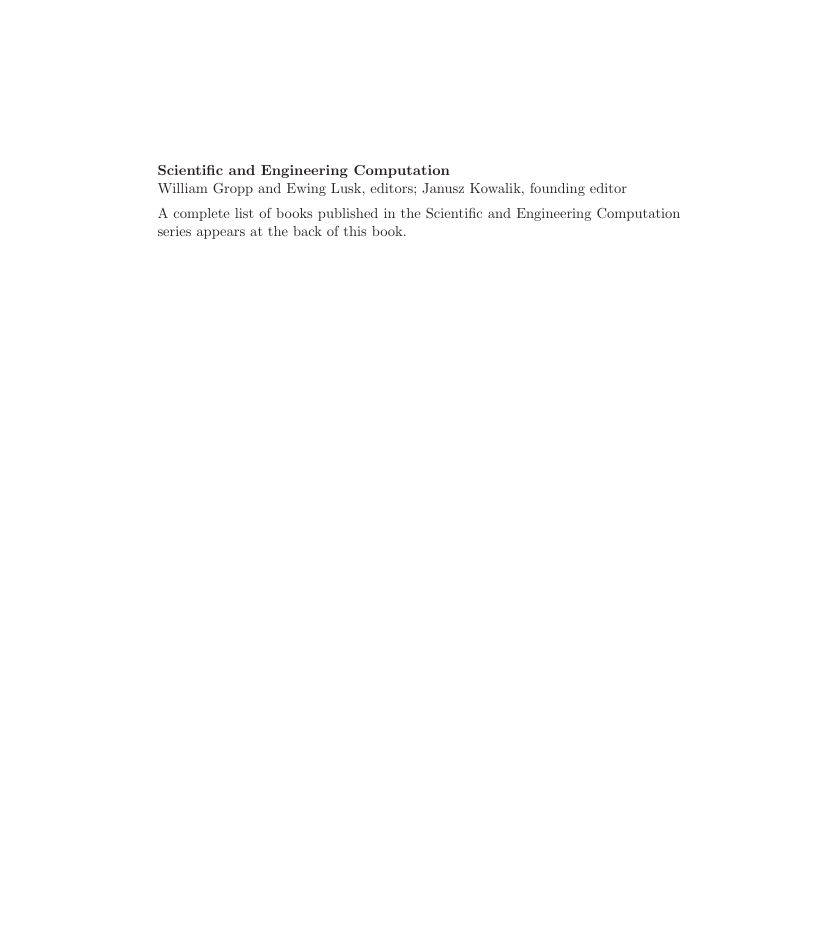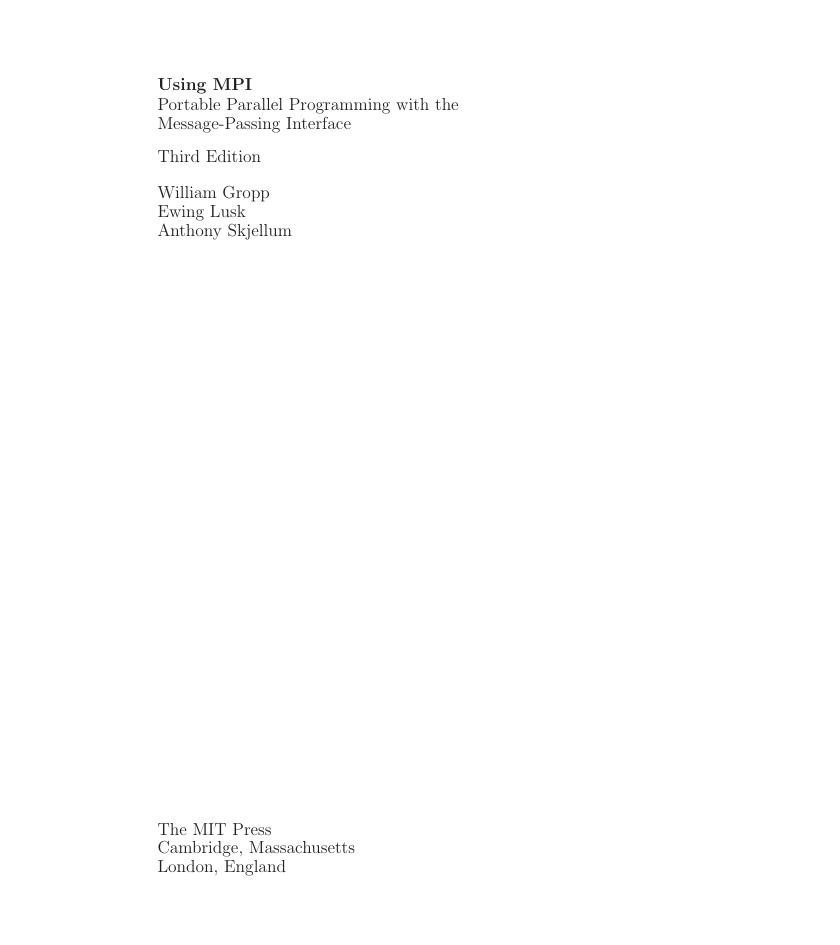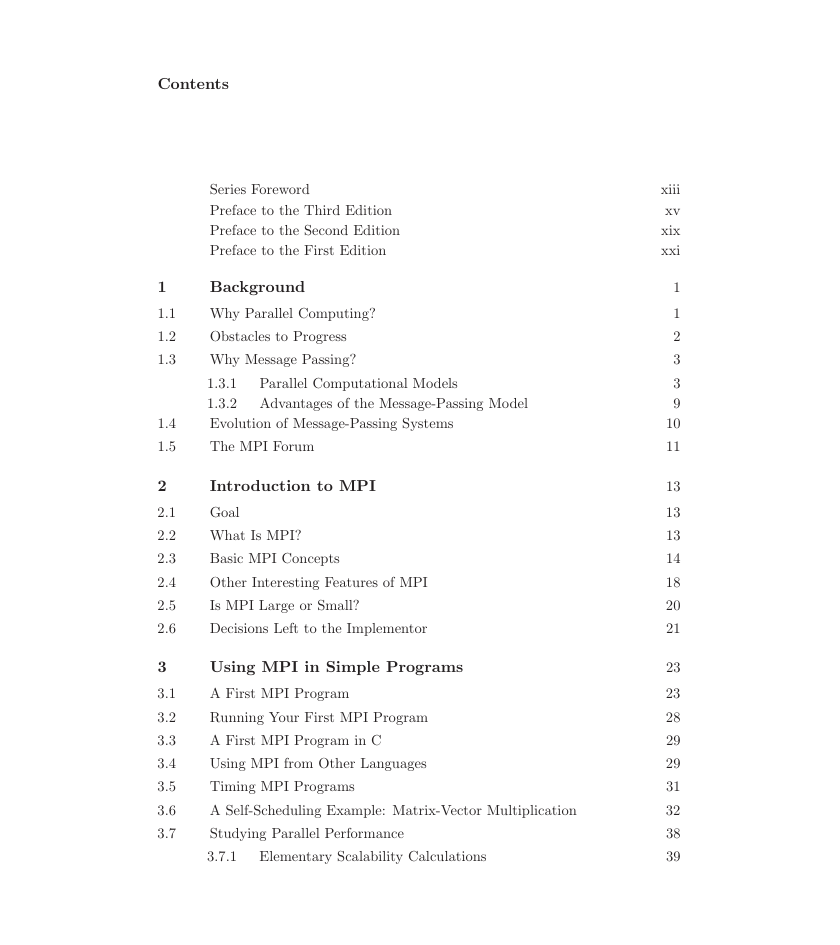�
Using MPI
Scientific and Engineering Computation
William Gropp and Ewing Lusk, editors; Janusz Kowalik, founding editor
A complete list of books published in the Scientific and Engineering Computation
series appears at the back of this book.
�
Using MPI
Portable Parallel Programming with the
Message-Passing Interface
Third Edition
William Gropp
Ewing Lusk
Anthony Skjellum
The MIT Press
Cambridge, Massachusetts
London, England
�
c 2014 Massachusetts Institute of Technology
All rights reserved. No part of this book may be reproduced in any form by any electronic or
mechanical means (including photocopying, recording, or information storage and retrieval)
without permission in writing from the publisher.
This book was set in LATEX by the authors and was printed and bound in the United States of
America.
Library of Congress Cataloging-in-Publication Data
Gropp, William.
Using MPI : portable parallel programming with the Message-Passing Interface / William
Gropp, Ewing Lusk, and Anthony Skjellum. — Third edition.
p. cm. — (Scientific and engineering computation)
Includes bibliographical references and index.
ISBN 978-0-262-52739-2 (pbk. : alk. paper)
1. Parallel programming (Computer science) 2. Parallel computers—Programming. 3. Computer
interfaces. I. Lusk, Ewing. II. Skjellum, Anthony. III. Title. IV. Title: Using Message-Passing
Interface.
QA76.642.G76
005.2’75—dc23
2014
2014033587
10 9
8
7
6
5
4
3
2
1
�
To Patty, Brigid, and Jennifer
�
Contents
Series Foreword
Preface to the Third Edition
Preface to the Second Edition
Preface to the First Edition
Background
Why Parallel Computing?
Obstacles to Progress
Why Message Passing?
Parallel Computational Models
Advantages of the Message-Passing Model
1.3.1
1.3.2
Evolution of Message-Passing Systems
The MPI Forum
Introduction to MPI
Goal
What Is MPI?
Basic MPI Concepts
Other Interesting Features of MPI
Is MPI Large or Small?
Decisions Left to the Implementor
Using MPI in Simple Programs
A First MPI Program
Running Your First MPI Program
A First MPI Program in C
Using MPI from Other Languages
Timing MPI Programs
A Self-Scheduling Example: Matrix-Vector Multiplication
Studying Parallel Performance
3.7.1
Elementary Scalability Calculations
1
1.1
1.2
1.3
1.4
1.5
2
2.1
2.2
2.3
2.4
2.5
2.6
3
3.1
3.2
3.3
3.4
3.5
3.6
3.7
xiii
xv
xix
xxi
1
1
2
3
3
9
10
11
13
13
13
14
18
20
21
23
23
28
29
29
31
32
38
39
�
viii
3.8
3.9
3.10
3.11
3.12
3.13
4
4.1
4.2
4.3
4.4
4.5
4.6
4.7
4.8
4.9
3.7.2 Gathering Data on Program Execution
3.7.3
Instrumenting a Parallel Program with MPE
Logging
Events and States
Instrumenting the Matrix-Matrix Multiply Program
Notes on Implementation of Logging
3.7.4
3.7.5
3.7.6
3.7.7 Graphical Display of Logfiles
Using Communicators
Another Way of Forming New Communicators
A Handy Graphics Library for Parallel Programs
Common Errors and Misunderstandings
Summary of a Simple Subset of MPI
Application: Computational Fluid Dynamics
3.13.1 Parallel Formulation
3.13.2 Parallel Implementation
Intermediate MPI
The Poisson Problem
Topologies
A Code for the Poisson Problem
Using Nonblocking Communications
Synchronous Sends and “Safe” Programs
More on Scalability
Jacobi with a 2-D Decomposition
An MPI Derived Datatype
Overlapping Communication and Computation
4.10 More on Timing Programs
4.11
4.12
4.13
Three Dimensions
Common Errors and Misunderstandings
Application: Nek5000/NekCEM
5
Fun with Datatypes
Contents
41
42
43
43
47
48
49
55
57
60
62
62
63
65
69
70
73
81
91
94
95
98
100
101
105
106
107
108
113
�
















 2023年江西萍乡中考道德与法治真题及答案.doc
2023年江西萍乡中考道德与法治真题及答案.doc 2012年重庆南川中考生物真题及答案.doc
2012年重庆南川中考生物真题及答案.doc 2013年江西师范大学地理学综合及文艺理论基础考研真题.doc
2013年江西师范大学地理学综合及文艺理论基础考研真题.doc 2020年四川甘孜小升初语文真题及答案I卷.doc
2020年四川甘孜小升初语文真题及答案I卷.doc 2020年注册岩土工程师专业基础考试真题及答案.doc
2020年注册岩土工程师专业基础考试真题及答案.doc 2023-2024学年福建省厦门市九年级上学期数学月考试题及答案.doc
2023-2024学年福建省厦门市九年级上学期数学月考试题及答案.doc 2021-2022学年辽宁省沈阳市大东区九年级上学期语文期末试题及答案.doc
2021-2022学年辽宁省沈阳市大东区九年级上学期语文期末试题及答案.doc 2022-2023学年北京东城区初三第一学期物理期末试卷及答案.doc
2022-2023学年北京东城区初三第一学期物理期末试卷及答案.doc 2018上半年江西教师资格初中地理学科知识与教学能力真题及答案.doc
2018上半年江西教师资格初中地理学科知识与教学能力真题及答案.doc 2012年河北国家公务员申论考试真题及答案-省级.doc
2012年河北国家公务员申论考试真题及答案-省级.doc 2020-2021学年江苏省扬州市江都区邵樊片九年级上学期数学第一次质量检测试题及答案.doc
2020-2021学年江苏省扬州市江都区邵樊片九年级上学期数学第一次质量检测试题及答案.doc 2022下半年黑龙江教师资格证中学综合素质真题及答案.doc
2022下半年黑龙江教师资格证中学综合素质真题及答案.doc